Rule of thumb suggests five years are necessary for a new golf course to reach peak conditions. To make this process smooth, many design firms will happily arrange yearly visits to tweak and amend as necessary.
More often, though, superintendents take the lead. Since preserving an architect’s vision and maintaining a course affordably don’t always go hand in hand, some superintendents—and owners—may even prefer to leave the architect out of the picture after construction is done.
Peter Knutzen is not one of those owners. A managing partner at the semi-private Old Toccoa Farm, he was glad to have Jack Dredla, the lead shaper on the project, stick around long after the design work wrapped up. Dredla has worked for Coore & Crenshaw, and he followed C&C associate Dave Axland to Bunker Hill Golf, the firm that Axland founded with Dan Proctor. Bunker Hill designed Old Toccoa Farm, which debuted its full 18-hole course earlier this year.
Axland and Proctor are master shapers—their blown-out bunkers have helped define Coore & Crenshaw’s style—but by their own admission, they don’t deserve all of the credit for Old Toccoa. After I talked to Proctor, he called me back less than five minutes later with an important note:
“I don’t know if I made this clear,” he said. “I consider Jack Dredla one of the designers. Not just one of the shapers. He’s got the imagination and the talent, and he deserves the designer [title]. Without Jack, that place would have been in trouble.”
Today, Dredla is still there, still trying to keep the course out of trouble.
Courses on flame with rocks and roll
If any course needs help maintaining its shape, Old Toccoa Farm is it. The fairways seem to melt off of north Georgia’s Blue Ridge Mountains, seeping down into the narrows between ridges. Many have already compared the warped fairways and eroded bunkers to Tobacco Road’s aesthetic. But whereas Mike Strantz played God in his passionate rendering of the Carolina Sandhills, Bunker Hill had to fight God in summoning Old Toccoa from the precipitous terrain.
“It’s interesting, I’ll tell ya. Sometimes I wondered if it would be playable at all, and I’m still not so sure,” Proctor says, perhaps joking. “The main hazard out there is gravity. We talked about gravity every time we built any feature.”
Bunker Hill’s efforts to soften the effects of gravity factor into almost all of the course’s 14 “hill” holes. In some places, first-and-a-half-cut Zoysia along the side of a sloping fairway prevents dead-center drives from kicking too aggressively down. Elsewhere, sizable fairway bunkers serve as roadblocks for misplaced tee shots. And still elsewhere, massive hollows off the greens collect balls from unwise go-for-the-green efforts. Give them bogeys, but don’t lose their Pro V1s.
-

No. 4 at Old Toccoa Farm, which exemplifies Bunker Hill's battle against gravity. Photo credit: Ryan Book
-

The steep 5th hole at Old Toccoa Farm. Photo credit: Ryan Book
And there are punchbowls. Lots and lots of punchbowls.
The designers want you putting, and they use punchbowls to help you onto the creative greens. Worried about landing in the valley short of the 171-yard par-3 8th? Go long! The back of the punchbowl will bring your ball back down—just make sure you’re on the correct end of the wide green, which is harelipped at the center with a pothole feeding back down the hill. Maybe you’ve just gotten up and down after a misinformed bomb on the short par-4 11th. The punchbowl assists your blind wedge, but an easy two-putt is foiled by a “Maxwell Muffin” in the middle. Grandest of all the punchbowls at Old Toccoa is the two-tiered one at No. 10. Ride the quarterpipe up to glory, or watch your birdie hopes roll down to the wrong plateau.
-

No. 8 at Old Toccoa Farm. Photo credit: Ryan Book
-
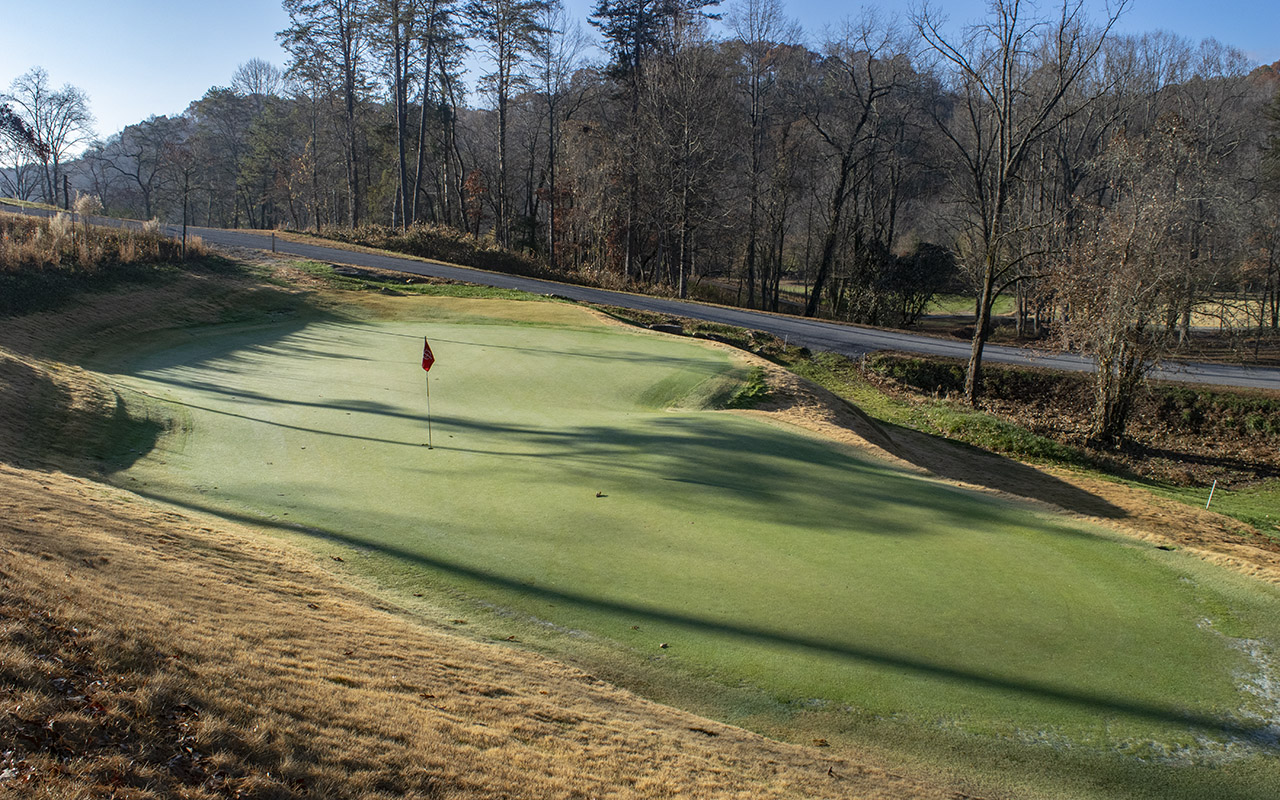
The 8th green at Old Toccoa Farm. Photo credit: Ryan Book
-

No. 11 at Old Toccoa Farm. Photo credit: Ryan Book
-
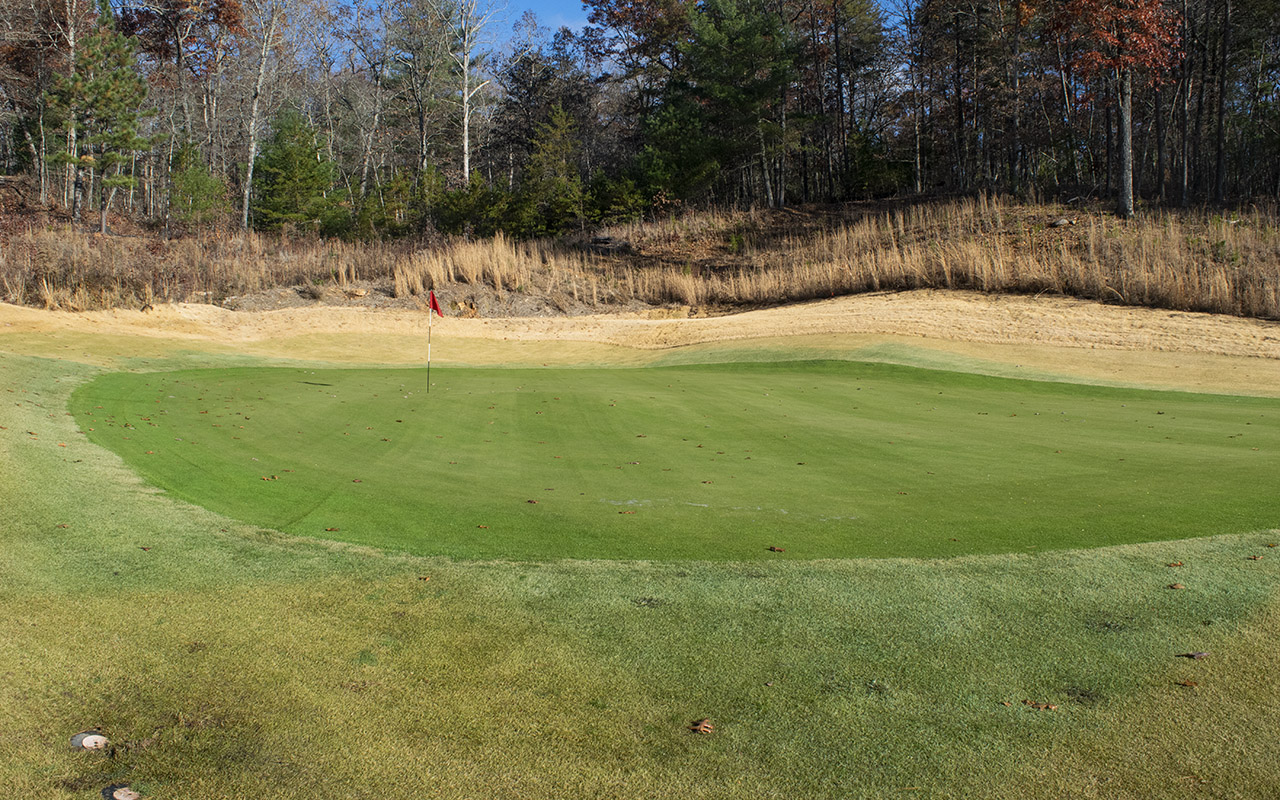
The 11th green at Old Toccoa Farm. Photo credit: Ryan Book
-
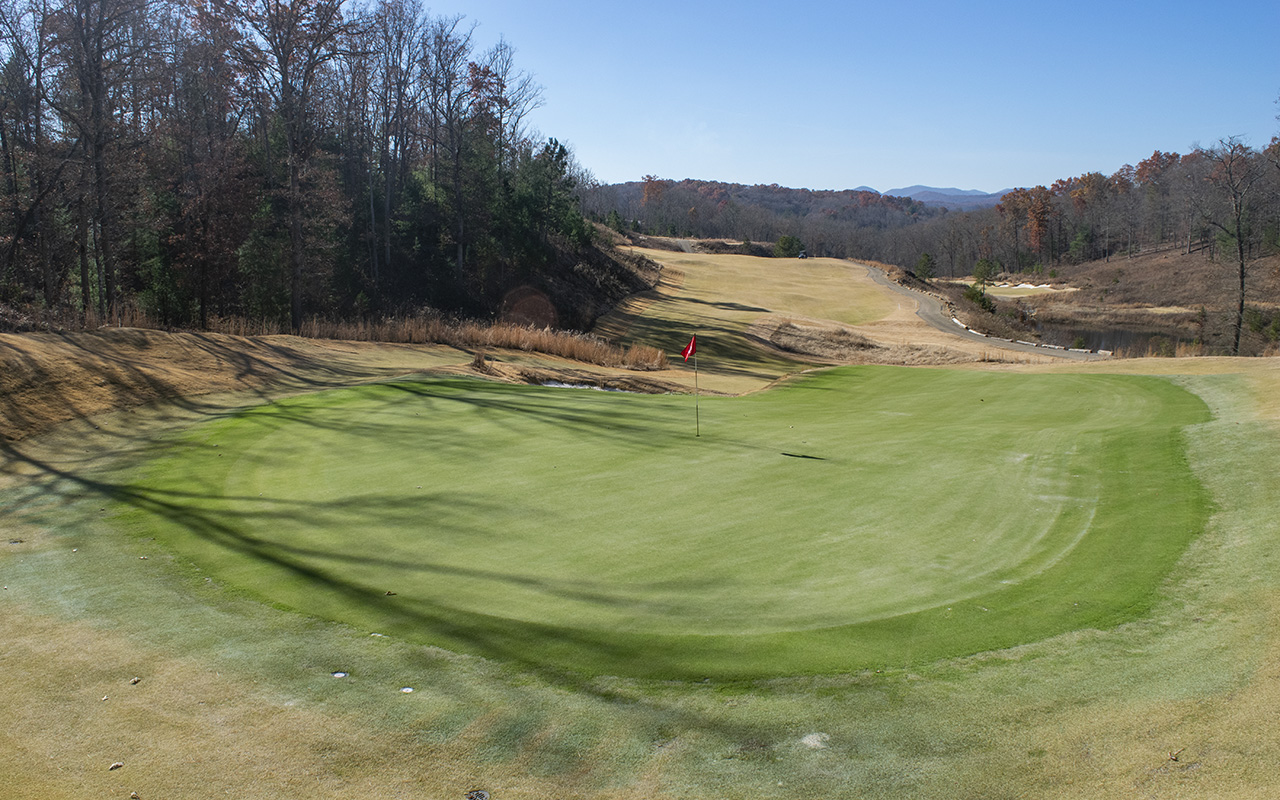
Behind the 10th green at Old Toccoa Farm. Photo credit: Ryan Book
Incremental wobbles around the greens and on the fairways make local knowledge more valuable than local muscle, which bodes well for the course’s primary clientele: recent (and not-so-recent) retirees.
For instance, Peter Knutzen tipped me off to a speed chute off the tee at No. 6. That boost made up for what happened on the blind approach to No. 2. A hidden mound repelled my seemingly perfect pitch-and-roll 25 feet to the left, converting a scoring opportunity into a harrowing two-putt.
-

The 6th fairway at Old Toccoa Farm. Photo credit: Ryan Book
-
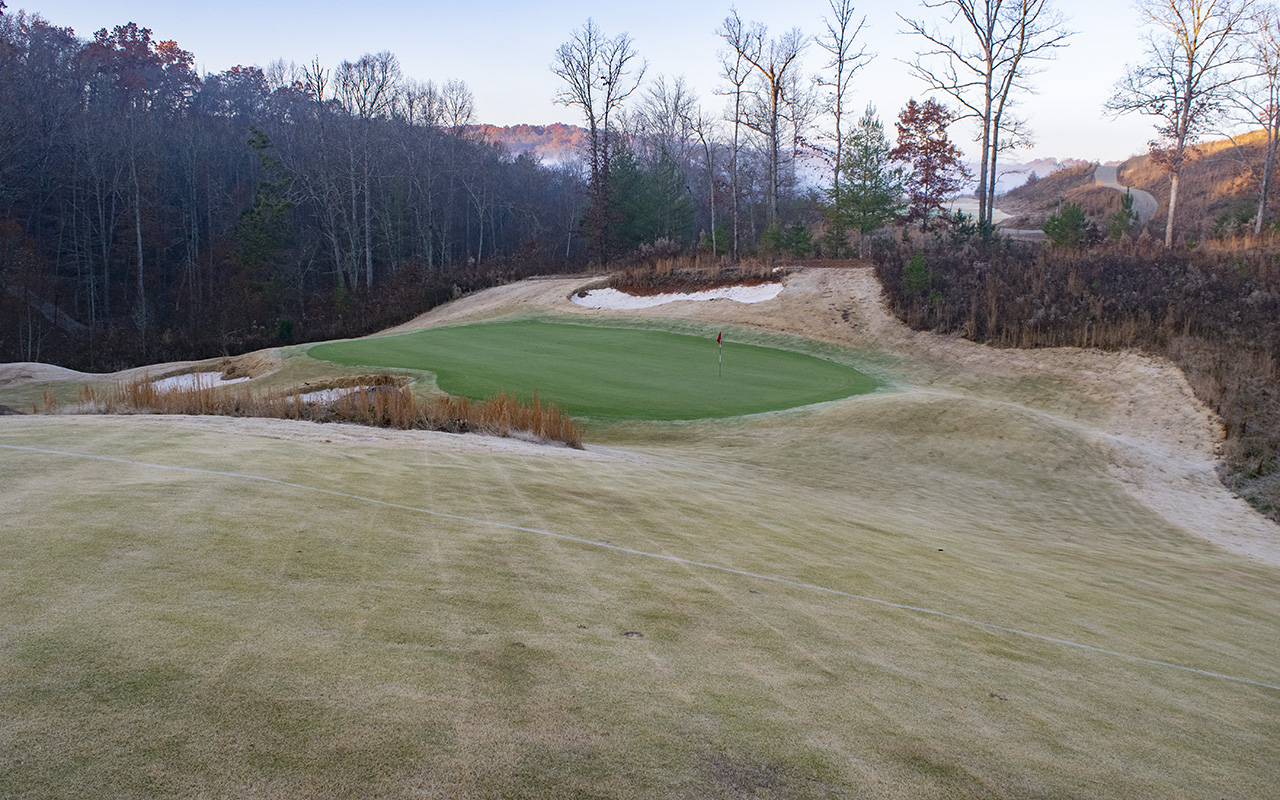
The moment that the 2nd green at Old Toccoa Farm comes into view. Photo credit: Ryan Book
Members will find plenty of nuances like these to pencil into their yardage books. And almost every bump owes its existence to Jack Dredla, whose input has always carried weight at Old Toccoa Farm.
(Don’t Dred) the shaper
It will surprise no one that architects and owners don’t always agree. Knutzen recalls butting heads with Axland over the concept behind the final hole.
Axland imagined No. 18 as a stiff par 4, 480 yards from the back tees. Knutzen, citing his proposed membership’s physical capabilities, deemed the idea ludicrous. So Dredla took a cart down to the hole and pondered it for 14 hours before reappearing at the temporary clubhouse. He presented Knutzen with a concept for a 480-yard par 5, lowering the green by 10 feet, adding a deep, thin bunker along the 40-yard-long green and a stretch of fairway to the right of the bunker. It’s as scorable as it is wreckable. A thrilling end to any tight match.
-
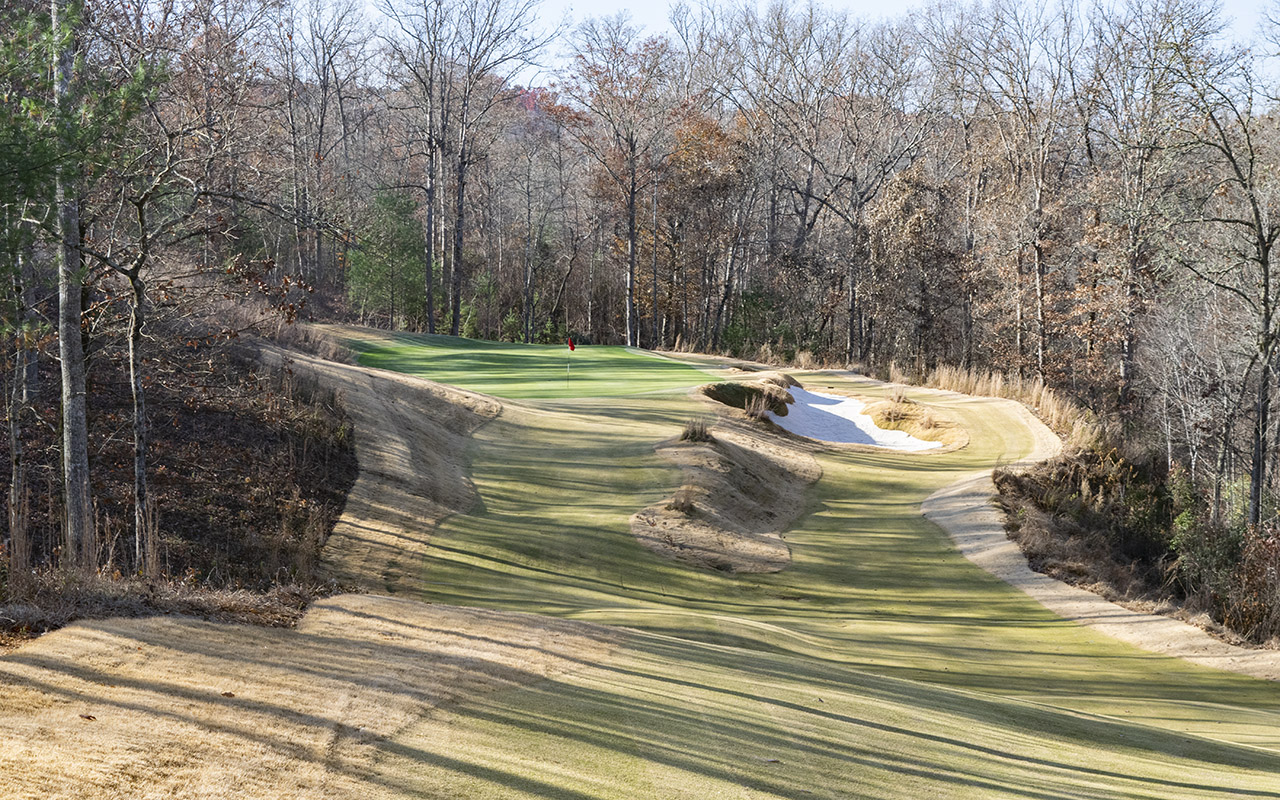
The approach to No. 18 at Old Toccoa Farm. Photo credit: Ryan Book
-
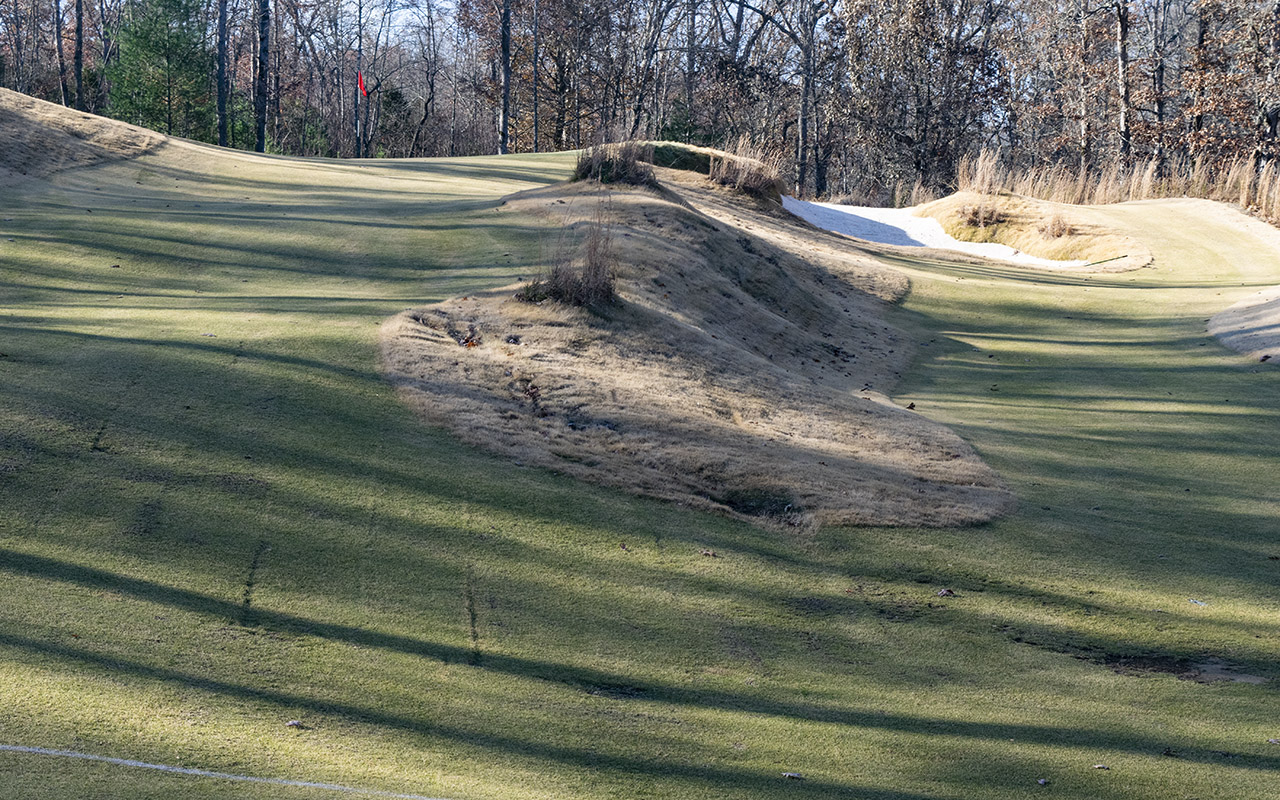
Closer to the 18th green at Old Toccoa Farm. Photo credit: Ryan Book
At that moment, Knutzen fully appreciated Dredla’s value. Axland and Proctor had already reached a similar conclusion.
“I hope Jack’s there the rest of his life, although he’s a die-hard Nebraska man,” Proctor says. “I’ll always say this: I’d be a fool not to offer him something, because he’s so talented.”
So why did Dredla stay on at Old Toccoa?
In 2015, right as the first nine holes opened for play, the shaper received a kidney cancer diagnosis. He was given one year to live. Although he had spent much of his career traveling—to Long Island for Friar’s Head, to China for Shanqin Bay—the shaper’s gypsy lifestyle suddenly lost its appeal. He had spent four years bringing Old Toccoa into the world; he figured he’d keep nurturing it as long as he could. Knutzen approved the idea immediately, signing Dredla as a full-time employee. What position, exactly? Knutzen says “jack-of-all-trades” with a smirk, subtly acknowledging the ambiguity of the post.
Now it’s four years later. Despite some prostate complications, Jack Dredla is still doing that job. “I’m feeling pretty good about it,” he says with a chuckle, referring to both his health and his employment.
Over these past four years, Axland and Proctor have made their presence at Old Toccoa as minimalist as their design philosophy. They trusted that their former shaper wouldn’t need much babysitting.
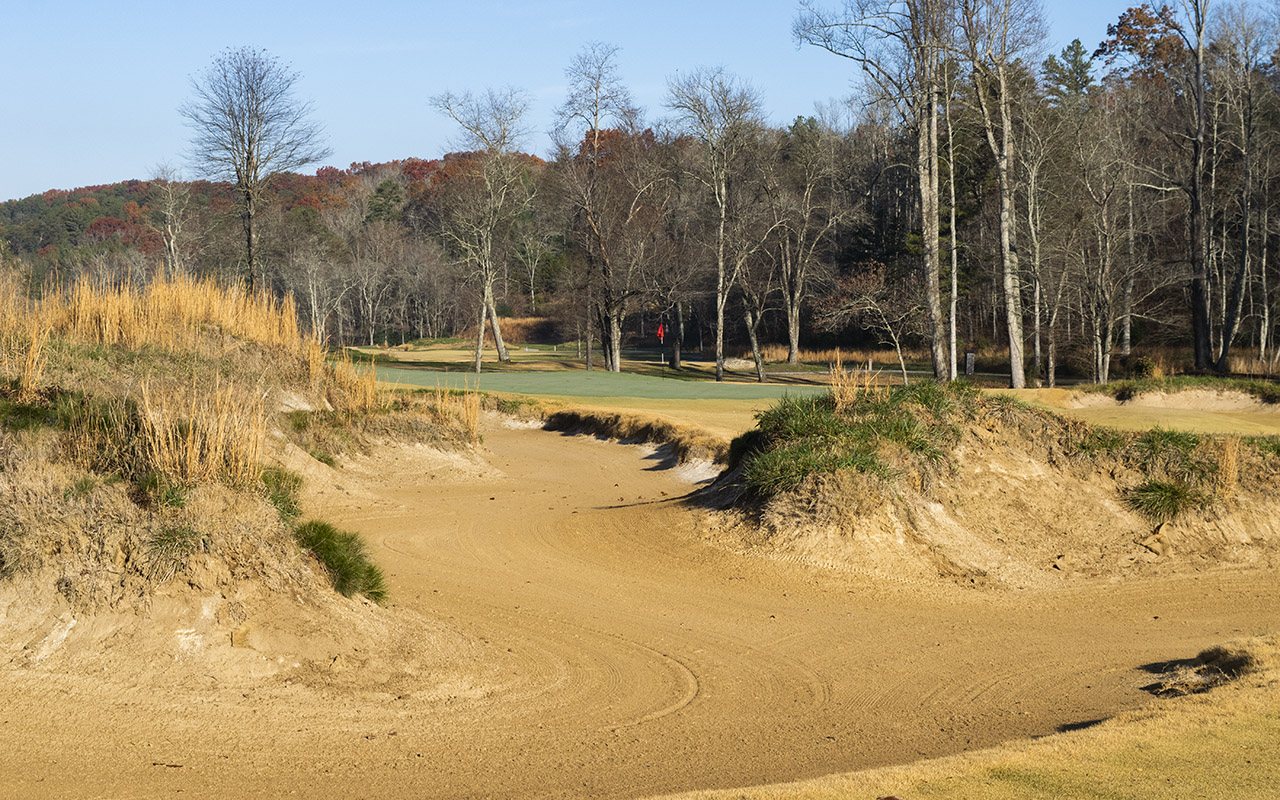
The carefully nurtured bunker next to the 7th green. Photo credit: Ryan Book
Dredla believes the maxim, taught to him by Bill Coore, that a golf course needs four to five years to reach maturity. Guiding this process isn’t sexy work. Dredla hasn’t needed to add or subtract another 10 feet of elevation from any other greens. Instead, he has been overseeing the cultivation of bluestem and lovegrass in the native areas. But the most ambitious of his projects has to do with every architecture aficionado’s favorite topic:
Cart paths.
Goin’ through the motions
Old Toccoa received 10 inches of rain during one week this past October. When we spoke, Dredla was accounting for where cart paths created unintended reservoirs along the course. (Bunker Hill’s original path plans had been ignored by the firm laying roadwork.) To collect a torrent of rainwater running through 20 yards of native off the first hole, he had installed a channel drain near the left fairway bunkers.
Small fixes like these abound at Old Toccoa, and Dredla is happy to handle them. He’s not a superintendent—and these aren’t the kinds of problems superintendents should have to deal with. Rainwater collecting in the bunkers at your local muni isn’t typically the maintenance team’s fault. More often it’s a design flaw, or a sign that renovation is needed.
“A superintendent could probably figure it out over time,” Dredla assures me. (He’s very friendly with Old Toccoa’s super, Jeff Buchman.) “It’s just quicker if somebody who’s been with it before, and knows when to put in a pipe and when not to and how to get the water away from the cart paths instead of running down it.”
And if one of the owners wants to remove his personal Eisenhower Tree? Dredla’s got Ralph Bunche-level negotiating skills. Proctor acknowledges that Dredla is closer with ownership than he is, and that pays off when Dredla needs to make the case for Bunker Hill’s original design concepts.
A certain attachment comes with building a course, as does a dread that laziness or budget cuts will destroy it all.
“It’s tough sometimes, and that’s part of why I want to be here to get everything right, because you leave a lot of courses and you come back and they’ve changed this or changed that. Some superintendents will just wipe out a bunker because they don’t like maintaining it or there’s a little water in it,” Dredla says. “We hate it when superintendents go in and make up their own mind to just change something and they don’t have any clue what they’re doing. So it’s very sentimental, just knowing that something’s gonna happen that ain’t what you wanted.”
Fortunately, for the majority of Dredla’s past projects, Coore & Crenshaw worked to maintain relationships and sent representatives annually after “completion.” Proctor notes, however, that Coore & Crenshaw, Doak, or Hanse tend to be welcomed back because they have clout. “Pissant” firms like Bunker Hill (Proctor’s word, not mine), on the other hand? “Sadly enough, when we walk away, we don’t get out to the courses very much, and we’re not invited back very often.”
Proctor sees hope in Knutzen’s ownership mentality, however. “Peter’s a very savvy individual. He recognizes the advantage to having someone like Jack there. Having Jack there, to me, is quality control. He’ll tell Peter, ‘Peter, that’s not a good idea.’ And Peter trusts him.”
I’m not the one to tell you what’s wrong or what’s right…
Old Toccoa Farm started in good hands, and it will stay in good hands for at least the next few years (Though Proctor did allude to a potential Dredla-led project in the shaper’s hometown of Hyannisport, Nebraska). It seems like a solid model—aside from the impossible expectation that every design firm will leave its lead shaper behind as a full-time father figure.
So what’s the middle ground?
Not to hover on how much people respect Coore & Crenshaw (maybe you’ve heard?), but top-level firms can apply pressure during superintendent hiring. Bunker Hill usually can’t. Still, firms like Axland and Proctor’s would do well to maintain connections with superintendents and to find ways to exert long-term influence. Sure, lesser-known architects may not want to kick down ownership’s door and declare themselves the Third Revelation, but a bit of self-importance wouldn’t hurt. Expanding a green? The super might be able to handle that alone with a master plan. Bunker construction? An architect really should supervise that task.
No doubt these matters are as tricky as they are important, and sometimes they fall entirely out of the architect’s control. That’s why Axland and Proctor feel so lucky that Jack Dredla decided to stick around at Old Toccoa Farm.
Dredla wasn’t around for my round, as he had just undergone surgery to remove his prostate (all went well). When Knutzen clambered off of a cart to greet me, he was beaten to the punch by an excitable dog. “It’s Jack’s dog, Rooney,” Knutzen explains.
Even when he isn’t prowling the course himself, Dredla’s got eyes on the ground to see his vision through.
Ryan Book writes mostly about golf and sometimes about music at his blog Bethpage Black Metal. Follow him on Twitter and Instagram.


 by
by 
